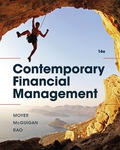
a.
To compute: Indifference points of EBIT and EPS.
a.
Explanation of Solution
Given information:
Tax rate: 40%
Average EBIT level: $6 million (per year)
Calculating EBIT-EPS indifference point:
Indifference can be seen, when debt financing EPS is considered equals to equity financing EPS,
Now,
Therefore, the indifference point will be seen when EBIT become $2.4million
b.
To compute: Earning per share for financial plan 1 and plan 2.
b.
Explanation of Solution
Calculating EPS for both financial plans:
| Plan 1 ($) | Plan 2 ($) | |
| EBIT | 6.0 | 6.0 |
| Interest | 0.0 | 1.2 |
| Earning before tax | 6.0 | 4.8 |
| Tax@40% | 2.4 | 1.92 |
| Earnings after tax | 3.6 | 2.88 |
| Outstanding shares | 2.0 | 1.0 |
| EPS | 1.80 | 2.88 |
Table (1)
Therefore, the earning per share for Plan 1 will be $1.80 and Plan 2 will be $2.88
c.
To determine: Factors for financial planning.
c.
Explanation of Solution
The factors for financial planning are as mentioned below:
- Capital structure, which is effectively followed by the parent company.
- Impact of financial plan on the financial status as well as stocks prices of the company.
- Probability distribution as per the expectation identified through EBIT.
d.
To determine: Suitable financial plan.
d.
Explanation of Solution
The plan 2 is must be recommended, because EPS (debt financing) is higher the EPS (equity financing).
e.
To compute: Earning per share when sales decreases by 5%.
e.
Explanation of Solution
Therefore, the time interest earned ratio will be 5 times.
f.
To compute: EBIT dropping level.
f.
Explanation of Solution
Therefore, the EBIT is supposed be drop by $1.8 (after deducting current EBIT from lower level). Along with that, it is required for the company to compliance with the agreement of loan.
g.
To compute: Probability of negative EPS.
g.
Explanation of Solution
Calculating earnings per share negative probability:
From Table V, the probability of a value greater than 2.0 standard deviations to the left of the mean is 2.28%, i.e. small.
Therefore, the probability of negative earning per share will be 2.28%.
Want to see more full solutions like this?
Chapter 14 Solutions
EBK CONTEMPORARY FINANCIAL MANAGEMENT
 EBK CONTEMPORARY FINANCIAL MANAGEMENTFinanceISBN:9781337514835Author:MOYERPublisher:CENGAGE LEARNING - CONSIGNMENT
EBK CONTEMPORARY FINANCIAL MANAGEMENTFinanceISBN:9781337514835Author:MOYERPublisher:CENGAGE LEARNING - CONSIGNMENT
